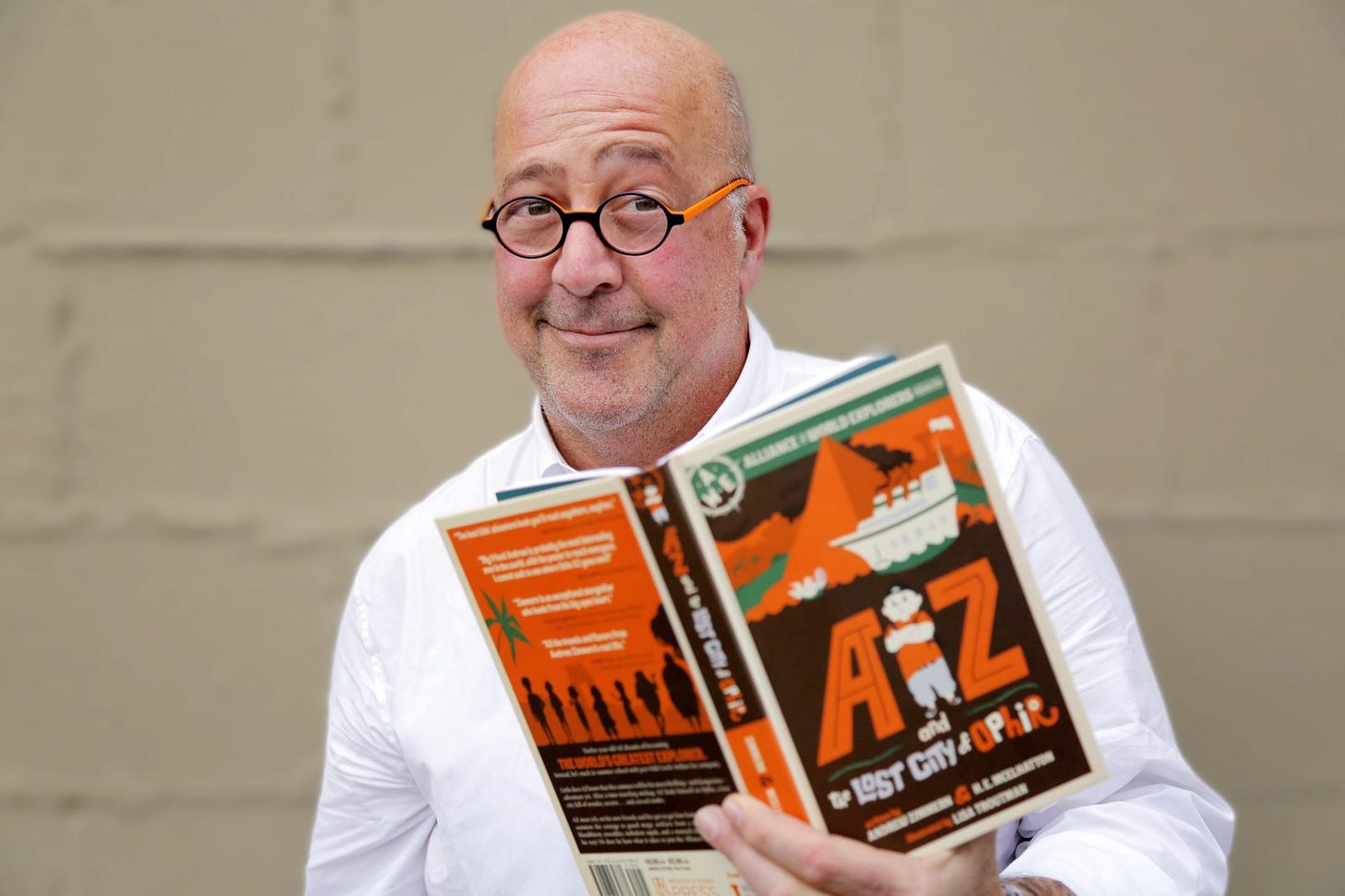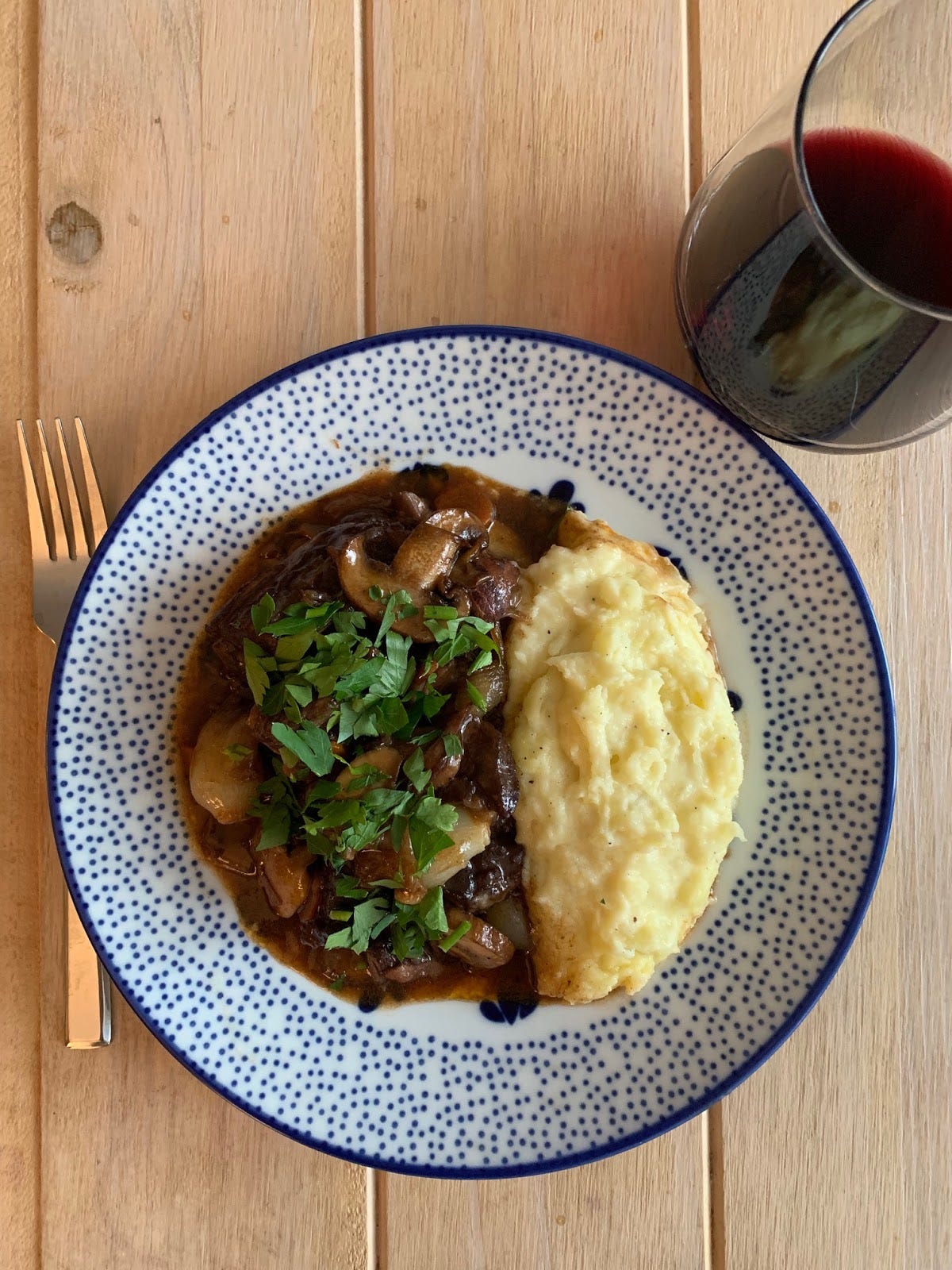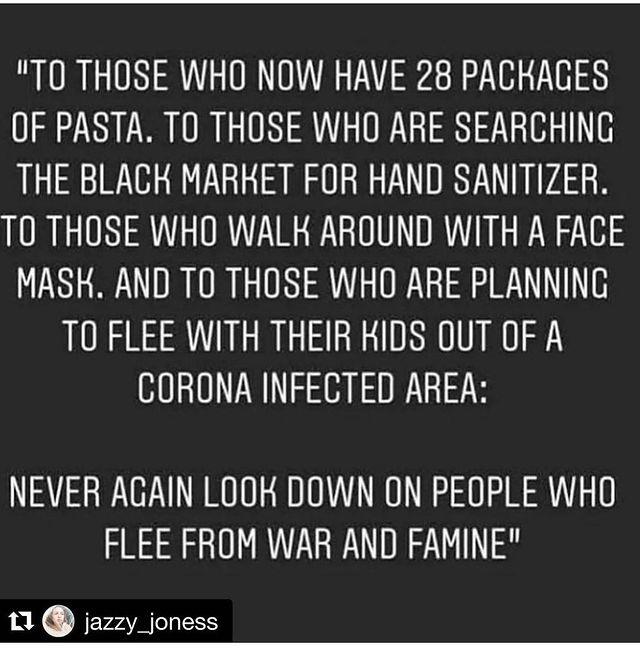Andrew Zimmern Says It’s Time To Cook Something New
Plus: The Case for Tuna Noodle Casserole—and Why COVID-19 Should Rally Wall Street Around Refugees. (We covered... a lot of terrain.)

As COVID-19 has swept across the world, supermarkets have taken on the ambiance of Walmart on Black Friday. But where most Americans see empty shelves, Andrew Zimmern—who spent 15 years eating poisonous frogs, cow placenta, and salted tuna sperm as the host of Bizarre Foods—sees a bounty: “People aren’t buying bulgur wheat!” he told me, incredulous.
[Editor’s Note: I didn’t have the heart to tell Andrew that I’d never heard of bulgur wheat, let alone eaten it.]
With so much food still in supermarkets, Zimmern believes Americans have no excuse not to try to make the best of every meal, even if they have to work with ingredients they’ve never before encountered—like, say, bulgur wheat. This isn’t a new battle for Zimmern. For more than 20 years, he told me, he’s been encouraging people to “cook something new,” and as Rabbi Hillel the Elder once said: “If not now, when?”
In today’s newsletter, the “What’s Eating America” host dishes on what to buy; what to cook; what charities to support; and why, despite everything, he still has hope.
I had a blast talking to Andrew—and I think you’ll get a lot out of this conversation. Or, at least, a recipe for how to cook bulgur wheat.
Here’s what we covered:
*Why he’s been buying the shelf-stable goods that people are ignoring
*The best ways to prepare bulgur wheat, lentils, and beans
*Why buying produce is one of the most patriotic things you can do right now
*Why you should make Tuna-Noodle casserole
*What to do with the anchovies sitting in your pantry—and why it’s so important to eliminate “meal fatigue”
*The lessons we should learn from this pandemic
*Two ways to give back
[Editor’s Note: Keep reading after the interview to learn why you should #BuyBiscotti; how you can support restaurant workers; and how to make Julia Child’s boeuf bourguignon.]
Why he’s been buying the food other people are ignoring
Andrew: I’ve been buying the shelf-stable goods that other people are ignoring—and I’m not saying that to pat myself on the back, it’s just that everyone seems to be buying rice. Of all the pantry items, I think that rice sales have increased 200% over where we were a couple weeks ago. Beans the same way.
But people aren’t buying bulgur wheat.
Tepary beans, people are staying away from, because they’re small and wrinkly and come in a smaller bag. I went to the Indian market and stocked up on red and green lentils. Because nutritionally, they are essentially equal with traditional dry black beans or kidney beans. But there’s also an advantage: they cook faster and require less liquid.
How to turn your bags of lentils into something delicious
Andrew: Red lentils are quicker-cooking than green ones, and much quicker-cooking than beluga lentils or Vert de Puy, the traditional French green lentil.
Red lentils, like certain types of peas, require anywhere from twenty to thirty minutes of cooking, and then they start to fall apart. Falling apart is okay—I actually like to cook them until they just are falling apart, so that I have a combination in the pot of whole ones that are soft and ones that fall apart and just are a beautiful, mushy texture.
So what do I do with them? I typically take a few tablespoons of oil and sweat vegetables—whatever I have: onions, carrots, celery, fennel, spinach, radish, turnip, parsnip. Throw in a bunch of herbs and a little bit of garlic. Sauté it for another minute or so. And then, I love the flavor of lentils and curry. So I immediately put in two, three, four tablespoons of curry powder, usually madras curry with some chiles added, or hot curry powder, and then I add a few cups of water or stock.
I prefer stock to broth, but some people may not have that; water’s fine. It only requires about 20 minutes of cooking, and you then can blitz it in a blender, and get a wonderful soup. You can leave them, as I do, half whole, half a little bit broken down, and serve them with rice, or just on their own as an unblended meal in a bowl.
READ: Andrew’s recipe for Vegetable Lentil Curry with Madras Curry Seasoning
People have to remember that these are superfoods. One of the things I learned traveling around the world for fifteen years making Bizarre Foods was: Simple, healthy, nutritious foods like beans, like lentils and other legumes and farinaceous foods are our best friends during these times. And so you want to make sure to always have them on hand.
Why buying produce is one of the most patriotic things you can do right now
Andrew: I was shocked at how many people went into panic mode, bought all these canned and processed foods—I’m assuming to stock up their pantry for a worst-case scenario—and there was not an empty slot in the produce bin. It’s crazy.
Here's the reality: This is not a physical disaster. The electricity grid is not going to go down. Water: As best we know it, this disease is not going to transfer into our water system. So I would encourage people, as long as there is fresh produce in the market, to focus on fresh produce, so that the stuff coming out of the farms keeps coming in. So we’re keeping people employed in the fields. So that harvesters and vegetable companies—like in the Salinas Valley in California, which I think supplies 40 percent of our country's produce—have the money and the resources coming in.
It's almost like a civic duty to eat more vegetables so that they can be providing for their workers, so that those workers can be providing for their families and can afford to stay safe when needed because they have income.
If all of a sudden we stopped buying vegetables, and they have to start laying off people, and people go to look for other jobs or other work or return home to countries of origin in the case of workers with visas or undocumented workers, that's going to be a huge disaster for our food system and our food supply chain. So buying produce is one of the most patriotic duties that you can do right now.
What to do with beans (if you can find them)
Andrew: The first ten days of this, I didn’t buy beans. The reason I cooked the beans last night was, the day before yesterday, when I went to my grocery store, I saw beans for the first time since this started, and it told me that people finally had enough beans in their house, so it was my turn to take the beans.
I let them soak overnight and then I boiled them for about two hours until they were tender, and then drained them. And I can take some and purée them, and make refried beans. I can put them in a Tex-Mex salad. I can fry them whole, sauté them whole in a pan, and season them as a side dish. There are so many things to do with them. And they’re loaded with protein, so they’re a fantastic superfood.
Why you should make Tuna-Noodle casserole
Three days ago, I made tuna-noodle casserole. Now, that, to me, is one of the world's great comfort foods. I love it. I load mine with peas, and I put some fresh dill in there, and I make my own sort of bechamel, then I put some chicken stock in and I cook the noodles and the tuna and everything together. It's a very, very, very satisfying comfort food for me.
There’s only so many tuna sandwiches you can eat. There’s only so many times you can sprinkle it over a salad. So a hot preparation like that is great.
READ: Bon Appétit’s tuna noodle casserole recipe. Per Andrew, you don’t need all of these vegetables; peas should suffice.
What to do with the anchovies sitting in your pantry—and why it’s so important to eliminate “meal fatigue”
You may have a two year old can of anchovies. First of all, a two year old can of anchovies is a year past its freshness date. Ignore that. They're safe to eat. Something that is that salted and preserved, that's sitting in olive oil? Legally, they have to put a freshness expiration on it, but that's really sort of a con job to get you to buy more.
Yes, if they're three or four years old, sadly, throw it away. I don't want to get anyone sick. But I just went into the pantry, three days ago, four days ago, and I saw that I had three cans of anchovies that I had bought recently. And there was one can of anchovies that was, like, two years old. So I took that and I blended it into a salad dressing.
Now, why is that some sort of earth-shattering news? Well, what it does is, it's one less oil-and-vinegar dressing that I have to make. Because, again, we are eating in more and more. We're cooking more and more, which I think is wonderful. But we have to eliminate meal and flavor fatigue for our families.
I've been telling people for 20 years when they ask, “What is there that Americans could do more of in their kitchens?” I say, “Cook something new.” Hopefully, two new things every week that they've never cooked before. It expands your skill set. You learn more. You make mistakes, but that helps you learn. The skill set and the practice and the growth of confidence you need in the kitchen comes from making mistakes and then surmounting them.
Most families have the regular rotation of four or five meals, because kids are like, “Oh, I love Daddy's pork chops.” And, you know, “Mom's lasagna is the best.” Mix. It. Up. We may be cooking at home for weeks and weeks and weeks, and you don't want your family to start pushing foods away, or from a psychological standpoint, not enjoy meal time.
Meal time is now a time when we can forget. Let's not complicate matters by putting the same old, you know, spaghetti and meatballs on the table again. At a certain point, if that's your only go-to item, you're going to need to increase your skill set. So that's why I made this anchovy dressing. I want to add: Even the anchovy haters at the table gobbled it down. I think they were pretty sick and tired of pulling out the Hidden Valley Ranch.
READ: Here’s a very simple recipe for anchovy dressing from NYT Cooking.
The lessons we should learn from this pandemic
I find solace in some silver linings, and one of the big ones is: When a forest burns down, all the arboreal experts and biologists all tell you that it's healthy for a forest. It promotes new growth.
And I hold onto that dearly because I think so many things in our world, in our society—convenience, speed, the distance between haves and have nots, the lack of equity in our culinary and restaurant system and our food business—a lot of our social problems tend to level-set when everyone loses. And right now, everyone is losing.
I do a lot of work with the International Rescue Committee—and I sent [their CEO] David Milliband a little something with a really, really simple idea:
We're seeing this right now all over the country. I mean, in Minnesota, people are going to their lake houses. Families in Kansas are driving into the rural parts of the country to stay with their cousins. Fat cats on Wall Street are driving to their fancy houses in the Hamptons.
It’s happening everywhere. And I don't think that's a bad idea.
But to all those people who are doing that and are experiencing things like that, stop demonizing refugees, because right now, everyone in this country should have a lot of empathy with those folks. I just think that there's an opportunity here to change how we view things in society and how we view other people and what we prioritize.
So I hope what comes out of this is, you know, a Wall Street 10 years from now that is supporting the IRC in a much more profound way, because those people can sit back and say, “Yeah, I remember getting gathering my children in the middle of the night, putting them in the station wagon, and driving us out to our summer home.”
And for the people out there who don't have second homes, and are having to shelter in place—and I'm one of those people—this is underscoring our commonality in America. We desperately needed that, right?
I learn every lesson in life through food. And we're learning that preparedness and diversity in what we know how to cook and can cook is important. And I think we can learn those same lessons socially and culturally.
Two ways to give back
My advice for people is to do two things: One, support your local food bank. The one right around the corner from you. They are the people, boots on the ground, who are making sure that food is getting to our most vulnerable people the fastest. That doesn't mean that there aren't great national charities. That doesn't mean that you shouldn't be Venmoing twenty bucks to your favorite server because they set up something at the restaurant to do it.
But I really think: Let's put our money and our canned goods into the hands of the people at the local level who've been doing it for, in some cases, 20, 30, 40 years. When it comes to food and taking care of people, go as small as you can. In other words, give as much to the people who are closest to you.
The second thing that you can do—and everyone always forgets about this—everyone is sitting there at home listening to you and me talk, and they’re nodding their head in agreement, right? But the 200 people on your email list, or the folks in your office on that internal email that everyone has at the office, are not like-minded. So get on your email and blast something out.
Everyone should be sending, if they can afford it, a 20-dollar check now to their local chapter of the Red Cross. Everyone should be going now and giving blood. Everyone should be doing those things now. The late Senator Paul Wellstone, one of my great mentors, said, “We all win when we all win.” I think that is absolutely the case, and I think we need to remember those words right now.
#BuyBiscotti
Okay, #BuyBiscotti isn’t a real hashtag, but it should be. I was forwarded an email this week saying Enrico Biscotti Company, a Pittsburgh bakery that’s been open for three decades, is in “dire straights” and had to lay off almost half its staff, which makes no sense, because THERE’S NEVER BEEN A BETTER TIME TO #BUYBISCOTTI.
As Anthony Mangieri explained in Thursday’s newsletter, biscotti 👏does👏not 👏go👏 bad. So if you #BuyBiscotti, you will have a dessert in your home, no matter how long this lasts. Here’s the link. The biscotti is 15% off. What are you waiting for?
Have money? Legal skillz? Accounting knowledge? Auditing bona fides? Here’s how you can help restaurant workers:
Bloomberg’s Kate Krader wrote a super helpful guide on how you can support restaurant workers—highlighting some of the non-profits doing the best work on this issue.
You should read the whole piece, but I want to shout out the Restaurant Workers Community Foundation, which is putting money directly in the pockets of the people who need it most. So, if you can donate, please do. If you can’t, per Helen Rosner’s Instagram, they’re also looking for people who can help with 1) Accounting; 2) Legal Work (specifically related to immigration and employment); 3) Auditing; and 4) Translation. If you can do any of that, email them at info@restaurantworkerscf.org.
I want to also shout out The COVID Clinician Meal Support Program. If you are feeling very generous—and are willing to donate more than $1,000—they will send meals from local restaurants to first responders in hospitals. This benefits two of the groups that need help most; and they’re already making a big impact:


Here’s a blog post with information on how you can get involved.
Homecooking Hacks
This recipe is from Kristina Costa, who you might know from such films as “Hillary” on Hulu, in which she can be seen making THIS face:

Here’s what she cooked this weekend:
I made Julia Child's boeuf bourguignon, a thing I try to make at least once a year and thought I would miss out on making this unseasonably warm winter but surprise! Quarantine! The ingredients are very basic and still readily available, at least here in DC. It takes a long time to complete and is a good mix of active and inactive time; it is not actually hard if you just follow the recipe. (There are actually three recipes because you sauté mushrooms and braise pearl onions separately; all three are available in their original form on the Knopf Doubleday website.)
Serve with buttered egg noodles or mashed potatoes. (I prefer mashed potatoes.) It also freezes well.
One tip: In this, the year 2020, you should skip the first couple of steps with boiling a bacon rind and whatnot and instead just chop bacon and sauté it, unless you have managed to procure slab bacon the way they used to sell it in midcentury.

I wonder if Julia Child ever ate bulgar wheat…
Until next time…




